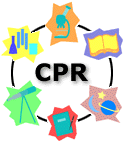By DSG Group on May 8, 2018

Although it’s not specific to the humanities, the teaching of writing is an important priority for undergraduate instruction. Often, we don’t think of technology as a way of helping students learn how to write, because computers can’t understand writing, and are poor judges of its quality.
That said, technology can help students become better writers by connecting them to other human readers through peer review. Peer review helps students get more feedback about their own writing, and also makes them more engaged in each other’s learning by giving them responsibility for each other’s learning. A number of educational technology tools allow students to peer review each other, and Calibrated Peer Review, or CPR, is one of the oldest and best-known. CPR was developed at UCLA, and in the past year, HumTech has contributed to the development of CPR. In this post, we’ll present CPR and how it’s used in classrooms.
The idea behind peer review is that students read each other’s writing and provide feedback to each other. In most peer review assignments, students are required to submit their own work and then respond to multiple peers’ work, so that each student gets reviews from multiple sources. This has the advantage of increasing the amount of feedback each student gets without increasing the amount of grading the instructor has to do. The goal of peer review is to benefit both the reviewer and the reviewee.
Like most peer review tools, in Calibrated Peer Review, students upload texts they have written and assign numerical scores to each other’s assignments. CPR goes one better by factoring each reviewer’s competency into the overall score. Why is this better? Research has shown that numerically-graded peer review is most effective when students are taught what makes a good and bad essay before they grade their peers. In CPR, an instructor uploads graded sample essays that students must review and score before they review their peers. From this calibration process, students receive a metric called a Reviewer Competency Index (RCI) based on how closely their grades match the grades the instructor assigned to the sample essays. When CPR calculates a final numerical score for the student’s essay from all of the peer reviews, CPR uses that student’s RCI: numerical grades from a student with a higher RCI are weighted more highly than grades from a student with a lower RCI.
A wide body of research has shown CPR to be effective in classes. Since it was developed in 1999, a number of instructors have researched its usefulness and conducted studies on it in various classes. These articles also outline best practices for CPR. Some examples include:
- Hartberg, Y., Guernsel, A. B., Simpson, N. J., & Balaster, V. (2008). Development of student writing in biochemistry using Calibrated Peer Review. Journal for the Scholarship of Teaching and Learning, 8(1), 29-44.
- Likkel, L. (2012). Calibrated Peer Review™ essays increase student confidence in assessing their own writing. Journal of College Science Teaching, 41(3), 42-47.
- Lawrence D. Margerum, M. Gulsrud, R. Manlapez, R. Rebong, and A. Love (2007). Application of Calibrated Peer Review (CPR) Writing Assignments To Enhance Experiments with an Environmental Chemistry Focus. Journal of Chemical Education, 84(2), 292-295.
In the past year, HumTech has contributed to integrating CPR with CCLE. CPR is now integrated fully with CCLE through a standard called Learning Tools Interoperability, or LTI. Soon, an instructor will be able to select it from the CCLE App Catalog and add it to their course without needing to do any additional work. This integration allows CCLE to perform the course management functions for CPR.
For more information about CPR, visit the CPR website.
